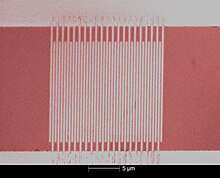

The superconducting nanowire single-photon detector (SNSPD or SSPD) is a type of optical and near-infrared single-photon detector based on a current-biased superconducting nanowire.[1] It was first developed by scientists at Moscow State Pedagogical University and at the University of Rochester in 2001.[2][3] The first fully operational prototype was demonstrated in 2005 by the National Institute of Standards and Technology (Boulder), and BBN Technologies as part of the DARPA Quantum Network.[4][5][6][7]
As of 2023, a superconducting nanowire single-photon detector is the fastest single-photon detector (SPD) for photon counting.[8][9][10] It is a key enabling technology for quantum optics and optical quantum technologies. SNSPDs are available with very high detection efficiency, very low dark count rate and very low timing jitter, compared to other types of single-photon detectors. SNSPDs are covered by International Electrotechnical Commission (IEC) international standards.[11] As of 2023, commercial SNSPD devices are available in multichannel systems in a price range of 100,000 euros.
It was recently discovered that superconducting wires as wide as 1.5 μm can detect single infra-red photons.[12][13][14] This is important because optical lithography rather than electron lithography can be used in their construction. This reduces the cost for applications that require large photodetector areas. One application is in dark matter detection experiments, where the target is a scintillating GaAs crystal. GaAs suitably doped with silicon and boron is a luminous cryogenic scintillator that has no apparent afterglow and is available commercially in the form of large, high-quality crystals.[15][16][17]
- ^ Natarajan, Chandra M.; Tanner, Michael G.; Hadfield, Robert H. (2012). "Superconducting nanowire single-photon detectors: Physics and applications". Superconductor Science and Technology. 25 (6): 063001. arXiv:1204.5560. Bibcode:2012SuScT..25f3001N. doi:10.1088/0953-2048/25/6/063001. S2CID 4893642.
- ^ Semenov, Alex D.; Gol'Tsman, Gregory N.; Korneev, Alexander A. (2001). "Quantum detection by current carrying superconducting film". Physica C: Superconductivity. 351 (4): 349–356. Bibcode:2001PhyC..351..349S. doi:10.1016/S0921-4534(00)01637-3.
- ^ Gol'Tsman, G. N.; Okunev, O.; Chulkova, G.; Lipatov, A.; Semenov, A.; Smirnov, K.; Voronov, B.; Dzardanov, A.; Williams, C.; Sobolewski, Roman (2001). "Picosecond superconducting single-photon optical detector". Applied Physics Letters. 79 (6): 705–707. Bibcode:2001ApPhL..79..705G. doi:10.1063/1.1388868.
- ^ Chip Elliott, "The DARPA quantum network", Quantum physics of nature. Theory, experiment and interpretation. in collaboration with 6th European QIPC workshop, Austria, 2005.
- ^ Martin A. Jaspan, Jonathan L. Habif, Robert H. Hadfield, Sae Woo Nam, "Heralding of telecommunication photon pairs with a superconducting single photon detector", Applied Physics Letters 89(3):031112-031112-3, July 2006.
- ^ BBN Technologies, "DARPA Quantum Network Testbed", Final Technical Report, 2007.
- ^ Hadfield, Robert H.; Habif, Jonathan L.; Schlafer, John; Schwall, Robert E.; Nam, Sae Woo (2006-12-11). "Quantum key distribution at 1550nm with twin superconducting single-photon detectors". Applied Physics Letters. 89 (24): 241129. Bibcode:2006ApPhL..89x1129H. doi:10.1063/1.2405870. ISSN 0003-6951.
- ^ Francesco Marsili. "High Efficiency in the Fastest Single-Photon Detector System". 2013.
- ^ Hadfield, Robert H. (December 2009). "Single-photon detectors for optical quantum information applications". Nature Photonics. 3 (12): 696–705. Bibcode:2009NaPho...3..696H. doi:10.1038/nphoton.2009.230. ISSN 1749-4885.
- ^ Esmaeil Zadeh, Iman; Chang, J.; Los, Johannes W. N.; Gyger, Samuel; Elshaari, Ali W.; Steinhauer, Stephan; Dorenbos, Sander N.; Zwiller, Val (2021-05-10). "Superconducting nanowire single-photon detectors: A perspective on evolution, state-of-the-art, future developments, and applications". Applied Physics Letters. 118 (19): 190502. Bibcode:2021ApPhL.118s0502E. doi:10.1063/5.0045990. ISSN 0003-6951. S2CID 236573004.
- ^ "IEC 61788-22-3:2022 | IEC Webstore". webstore.iec.ch. Retrieved 2023-04-29.
- ^ Luskin et al. (2023). “Large active-area superconducting microwire detector array with single-photon sensitivity in the near-infrared”, Appl. Phys. Lett. 122, 243506. https://doi.org/10.1063/5.0150282
- ^ G.-Z. Xu et al. (2023). “Millimeter-scale active area superconducting microstrip single-photon detector fabricated by ultraviolet photolithography,” Optics Express, vol. 31, pp. 16348-16360.
- ^ Yabuno M.; China F.; Terai H.; Miki S. (2023). “Superconducting wide strip photon detector with high critical current bank structure”, Optica Quantum, 1: 26-34
- ^ Derenzo, S.; Bourret, E.; Hanrahan, S.; Bizarri, G. (2018). "Cryogenic scintillation properties of n-type GaAs for the direct detection of MeV/c2 dark matter". Journal of Applied Physics. 123 (11): 114501. arXiv:1802.09171. Bibcode:2018JAP...123k4501D. doi:10.1063/1.5018343. S2CID 56118568
- ^ Vasiukov, S.; Chiossi, F.; Braggio, C.; Carugno, G.; Moretti, F.; Bourret, E.; Derenzo, S. (2019). "GaAs as a Bright Cryogenic Scintillator for the Detection of Low-Energy Electron Recoils from MeV/c2 Dark Matter". IEEE Transactions on Nuclear Science. 66 (11): 2333–2337. Bibcode:2019ITNS...66.2333V. doi:10.1109/TNS.2019.2946725. S2CID 208208697
- ^ Derenzo, S.; Bourret, E.; Frank-Rotsch, C.; Hanrahan, S.; Garcia-Sciveres, M. (2021). "How silicon and boron dopants govern the cryogenic scintillation properties of n-type GaAs". Nuclear Instruments and Methods in Physics Research Section A. 989: 164957. arXiv:2012.07550. Bibcode:2021NIMPA.98964957D. doi:10.1016/j.nima.2020.164957. S2CID 229158562